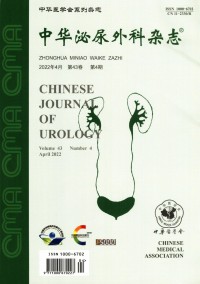膀胱肾源性腺瘤8例报告及文献复习
Q4 Medicine
引用次数: 0
摘要
目的分析膀胱肾源性腺瘤的临床特点。方法回顾性分析2016年7月至2019年6月8例膀胱肾原性腺瘤患者的临床和病理资料。患者年龄33~71岁,平均年龄55岁,其中男性5例,女性3例。临床表现为血尿7例,尿路刺激6例,无明显症状1例。其中膀胱炎7例,尿石症3例,膀胱癌症2例,侵袭性结肠肠系膜纤维瘤1例,无其他并发症1例。5例有泌尿外科手术史。侧壁为首选部位5例;孤立5例;肿瘤的平均最大直径为0.9cm(范围0.1-1.8cm)。膀胱镜下可见乳头状肿块,表面鲜红色,蒂不明显,乳头粗短,触摸易出血;它们中的一些是分散的和地衣样的变化。所有患者均接受经尿道膀胱黏膜切除术。结果病理检查显示膀胱黏膜慢性炎症,间质水肿,肉芽组织增生,嗜酸性粒细胞浸润,中肾样上皮化生。8例患者均接受电话随访2~38个月,平均17.1个月。到目前为止,还没有发现复发。结论膀胱肾源性腺瘤的诊断依赖于病理检查。在操作过程中必须将其完全移除。术后复发和恶性肿瘤应及时治疗。关键词:膀胱肿瘤;肾源性腺瘤;病理学本文章由计算机程序翻译,如有差异,请以英文原文为准。
The nephrogenic adenoma of the bladder: 8 cases and literature review
Objective
To analyze the clinical characteristics of nephrogenic adenoma of the bladder.
Methods
The clinical and pathological data of 8 patients with bladder nephrogenic adenoma, during the period from July 2016 to June 2019, were retrospectively analyzed. Patients’ age were 33 to 71 years old and the average age was 55, including 5 males and 3 females. The clinical manifestations were hematuria in 7 cases, urinary tract irritation in 6 cases, and no obvious symptoms in 1 case. There were 7 cases with cystitis, 3 cases with urolithiasis, 2 cases with bladder cancer, 1 case with invasive colonic mesentery fibroma, and 1 case without other complications. 5 cases had the history of urological operation. The predilection site was the lateral wall with 5cases; 5 cases were solitary; the average maximum diameter of the tumor was 0.9 cm (range 0.1-1.8 cm). Under cystoscope, papillary mass can be seen, the surface is bright red, the pedicle is not obvious, the papilla is thick and short, easy to bleed when touching; some of them are scattered and lichen like changes. All patients received transurethral resection of bladder mucosa.
Results
Pathological examination shows that the bladder mucosa showed chronic inflammation, interstitial edema, granulation tissue hyperplasia, eosinophil infiltration and metaplasia of mesonephroid epithelium. All of the 8 patients were followed up by telephone for 2 to 38 months, with an average of 17.1 months. So far, neither recurrence has been detected.
Conclusions
The diagnosis of nephrogenic adenoma of the bladder depends on pathological examination. It must be totally removed during operation. The recurrence and malignancy should be treated in time after operation.
Key words:
Urinary bladder neoplasms; Nephrogenic adenoma; Pathology
求助全文
通过发布文献求助,成功后即可免费获取论文全文。
去求助
来源期刊

中华泌尿外科杂志
Medicine-Nephrology
CiteScore
0.10
自引率
0.00%
发文量
14180
期刊介绍:
Chinese Journal of Urology (monthly) was founded in 1980. It is a publicly issued academic journal supervised by the China Association for Science and Technology and sponsored by the Chinese Medical Association. It mainly publishes original research papers, reviews and comments in this field. This journal mainly reports on the latest scientific research results and clinical diagnosis and treatment experience in the professional field of urology at home and abroad, as well as basic theoretical research results closely related to clinical practice.
The journal has columns such as treatises, abstracts of treatises, experimental studies, case reports, experience exchanges, reviews, reviews, lectures, etc.
Chinese Journal of Urology has been included in well-known databases such as Peking University Journal (Chinese Journal of Humanities and Social Sciences), CSCD Chinese Science Citation Database Source Journal (including extended version), and also included in American Chemical Abstracts (CA). The journal has been rated as a quality journal by the Association for Science and Technology and as an excellent journal by the Chinese Medical Association.
 求助内容:
求助内容: 应助结果提醒方式:
应助结果提醒方式:


